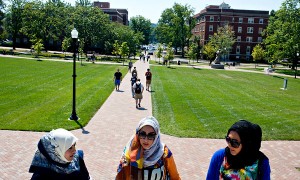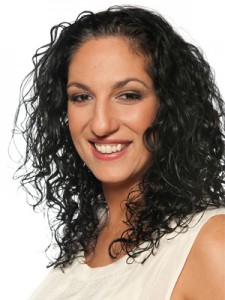The other day, I stumbled across a piece on the increasing number of Muslim students at Catholic colleges in the United States. The New York Times article is the result of interviews with students and administrators at several American Catholic institutions. Also accompanying the article was the usual array of pictures depicting Muslim women in colorful hijabs on campus, further underscoring the author’s thesis of “thriving Muslims” at US colleges. While I appreciate the author’s attempt to highlight an emerging trend, how is the increased attendance of “Muslim” international students any different the thousands of Muslims (Americans and otherwise) already attending world-renowned colleges and universities in the US?
Firstly, I find the title not only off-putting but also somewhat inaccurate. “Muslims From Abroad Are Thriving in Catholic Colleges” sounds like a caption akin to “Aliens From Outer Space Are Thriving on Earth”. Moreover, while the title appears to refer exclusively to expatriate Muslims, the author also cites the example of Pakistani American, Maha Haroon, a pre-med undergraduate who chose Creighton University, a Catholic university in Omaha (Nebraska). This leads me to question if there has been a general increase in American Muslims attending Catholic colleges and universities in the US.
From the outset, the author is quick to point out that while no definitive figures are available, on average, the Muslim student population at Catholic colleges has doubled over the past decade with the number of Muslim women tripling or more. At the same time, this assessment could also hold true in terms of a general increase in Muslim students across all American colleges and universities and not necessarily just Catholic institutions. According to this, the number of international students attending US universities and colleges has risen by five percent to 723,277 during the 2010/11 academic year. Saudi Arabia and Iran are among several countries which have experienced the strongest increases in the number of students. Saudi Arabia in particular owes this increase to its expansive scholarship program. Additionally, since much of the Arab world is experiencing a jump in the number of women attending tertiary education institutes, it comes as no surprise that Catholic colleges have experiences a similar rise in female Muslim students.

The article specifically cites examples from the University of Dayton (Dayton, Ohio), Creighton University in Omaha and Marymount University (Arlington, Virginia). According to the author, a decade ago, the University of Dayton, with 11,000 undergraduate and graduate students, had just 12 students from predominantly Muslim countries, all of them men. This number has jumped to 78 of which approximately one-third are women.
The main reason for attending Catholic colleges is described as a general preference for an environment where “adherence to a religious code are accepted and even encouraged, socially and academically”. Many of the students interviewed (mostly women) suggested (correctly or not) that they are more accepted at Catholic colleges than secular ones. What such a response tells me is that some Muslim students just have a preference for faith-based institutions like American Catholic colleges in the same way some Muslim students might prefer an academic program in one university over another. This explains why thousands of Muslims continue to attend secular schools all over the US. Actually, in another article on Muslim students attending Catholic colleges, one student clearly indicates that it was a matter of academics and considered Boston’s Catholicism a drawback. Muslim students at Dayton also appreciate that the university has set aside special prayer and ablution rooms for them in addition to providing requisite assistance to students to help them celebrate major religious holidays.
The article puts particular focus on women – in that many Muslim students, particularly women, say they based their college choices partly on the idea that Catholic schools would be less permissive than others in the United States. Interestingly, they have since reconsidered this idea based on behavior they have witnessed at the college. Additionally the prevalence of single-sex floors in dorms also makes things easier for them. In this regard, for many families who find the alleged racier aspects of certain liberal colleges off-putting, Catholic colleges seem like an ideal alternative. The author also discusses the varied attire worn by Muslim women as supported by the photographs. No reference, however, is made to whether veiling impacted the decision of the women to choose Catholic colleges. A Saudi interviewee (who wears a cloak and face veil) briefly alludes to having to move because she felt disrespected in her previous university.
Another aspect the author should have addressed is that Muslims attending Catholic educational institutions is nothing new. In many predominantly Muslim countries, Catholic missionary schools have been part of the landscape for years. In Pakistan, top notch schools include Saint Patrick’s High School, Karachi and Saint Mary’s Academy in Rawalpindi. While I am not clear about the extent of Catholic influence on academics, both schools have produced members of the social and political elite of Pakistan. The schools are under the management of the Diocesan Board of Education of the Catholic Diocese of their respective cities.
N.B. As a non-hijab-wearing Pakistani woman, I have had the opportunity to attend Ruamrudee International School, a Catholic school in predominantly-Buddhist Thailand, where I attended primary school. I just remember my Christian friends disappearing from time to time to visit the chapel, while we took an ethics class. My father too is a graduate of St. Anthony’s in Sialkot, another Catholic school.











